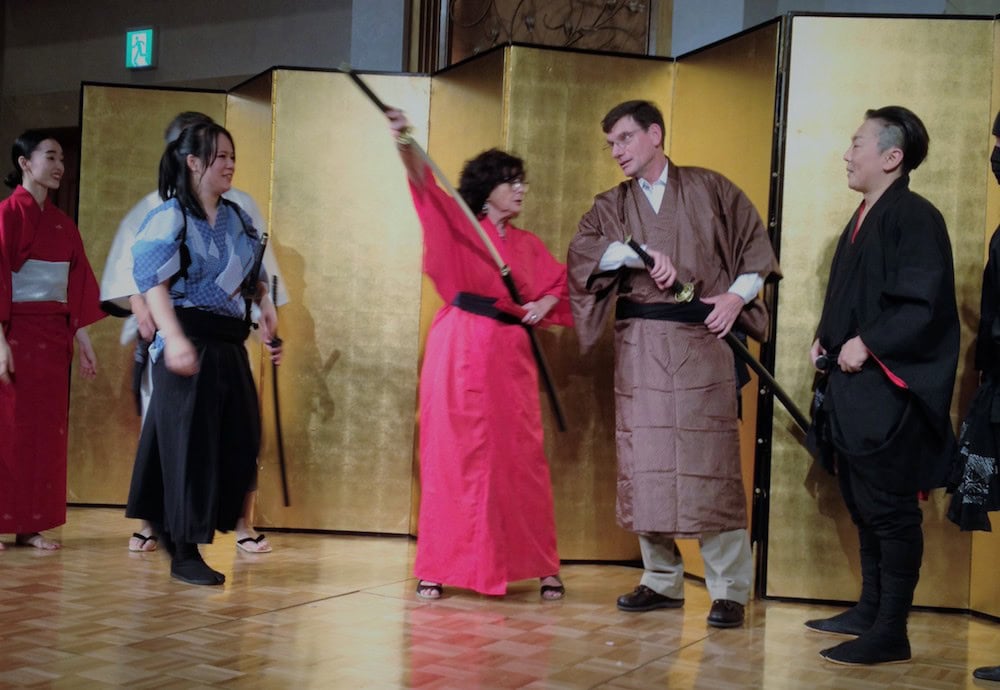
[Image above] ACerS members Alicia Duran and Steve Martin wield swords on stage during the entertainment part of the conference banquet. Credit: Klaus Bange
Editor’s note: This report comes to us from J.M. Parker, University of Sheffield, UK.
Nearly 600 delegates representing 29 countries converged on Yokohama, Japan, for the International Commission on Glass’ 59th Meeting on the Glass and Photonic Materials (ICG 2018) in conjunction with the 14th Symposium of the Glass Industry Conference of Japan, September 23–26, at the PACIFICO Yokohama Conference Center. Although the weather only reached the upper twenties, the atmosphere inside the conference center was bright and dynamic.
The PACIFICO Yokohama Conference Center, given its seaside location, was appropriately shaped like the sails of a yacht. It offered fascinating panoramic views of the surrounding coast and the harbor with its replica early 20th-century sailing ship, which was somewhat dwarfed by huge cruise liners.
Two plenary sessions kicked off the conference with the overall theme, ‘Innovations in Glass and Glass Technologies: Contributions to a Sustainable Society.’ Deputy Dean, MJIIT (Malaysia Japan International Institute of Technology) at Kuala Lumpur, Malaysia, and University of Tokyo Professor Emeritus Akio Makishima spoke on the topic, Scientifically really important or technologically really important.
Chief executive officer and president of Asahi Glass Co. Ltd Takuya Shimamura spoke on The past, present and future of Japan’s glass industry—Its contribution to our sustainable society. Last year’s Gottardi Award recipient, Ashutosh Goel, from Rutgers University concluded the opening session with a talk in place of this year’s recipient Shifeng Zhou of South China University of Technology, who was unable to attend.
Four more keynotes rounded out the conference’s theme and 60 invited speakers delivered presentations on one of six sub-themes: glass production technology; radioactive waste; glasses for photonic technologies; electric and magnetic functions; crystallization and glass ceramics; and atomistic views of glass. Two hundred more speakers delivered oral presentations and 100 presenters shared their research through poster presentations.

Attendees at ICG 2018 listen to a variety of speakers on topics related to glass science and technology. Credit: Klaus Bange
One feature of the conference was its focus on young people. Each day during the lunch hour, organizers set aside a room for a talk and opportunity to link students to available mentors. The short talk by a different younger glass technologist each day gave a feel for available career paths and how to approach job hunting. Students then gathered in groups around an allocated table to discuss their thoughts and questions at a more personal level with an allocated mentor.
Attendees enjoyed the conference banquet in the main conference hotel with an excellent menu of typical local food. During the meal, attendees were treated to a display by a local dance group dressed as Samurai warriors. Following their initial display, they persuaded two volunteers from the audience, Steve Martin and Alicia Duran, to participate—both of whom survived the experience intact in spite of the swords they wielded! The visual display was supplemented by an amazingly dextrous musical performance on a Shamisen, a Japanese stringed instrument, together with a wind instrument called a Shakuhachi.
Although few attendees participated, conference organizers planned two outside events. Concluding the first day was a tour of Tokyo, which gave participants an opportunity to try glass blowing. The aim was to make a traditional Japanese wind chime. Japanese temples, gardens and high buildings provided a taste of Japanese culture. For the second tour, participants went to Kamakura and were guided by a local English-speaking guide who was keen to provide not only views of the ancient sites there such as the giant Buddha, but to explain the philosophies behind the Japanese lifestyle.
A tradition at the closing ceremony is to provide the delegates with final statistics from the conference. Out of the 588 delegates from 29 countries, there were 88 students and 12 retirees. The number of attendees from each country were as follows: 376 from Japan, 29 from China, and Germany and the U.S. were close behind with 24 delegates each. Ninety-five attendees came from 17 different European countries: France, U.K., Belgium, Czech Republic, Italy, Netherlands, Slovakia, Denmark, Spain, Finland, Liechtenstein, Slovenia, Turkey, Bulgaria, Croatia, Portugal, and Sweden. There were also 30 attendees who came from other Asian countries: South Korea, Thailand, Singapore, Taiwan, India and Malaysia. Six attendees came from Russia and four came all the way from Brazil.
Stevanato again provided a prize for the best poster, while the local organizing committee selected the best 10 student posters, acknowledging their success as part of the closing ceremony.
ICG also held meetings of several of its committees, and elected Alicia Duran as the 25th ICG president during the council meeting. She follows Manoj Choudhary, who has completed his term as president. She will share her vision for the future in a separate press release and on the ICG web site.
After acknowledging the staff, contributors, and many sponsors who helped to make Yokohama such a successful conference, the final act was for the representatives of The American Ceramic Society to issue an invitation to all those present to participate in the 25th International Congress on Glass in Boston, Massachusetts, June 9–14, 2019.
Author
J.M. Parker
Spotlight Categories
- Meeting Highlights
Related Posts
Volunteer spotlight: Hyunjun Kim
December 18, 2025
ACerS GOMD History – A Look Back in Time
December 10, 2025


